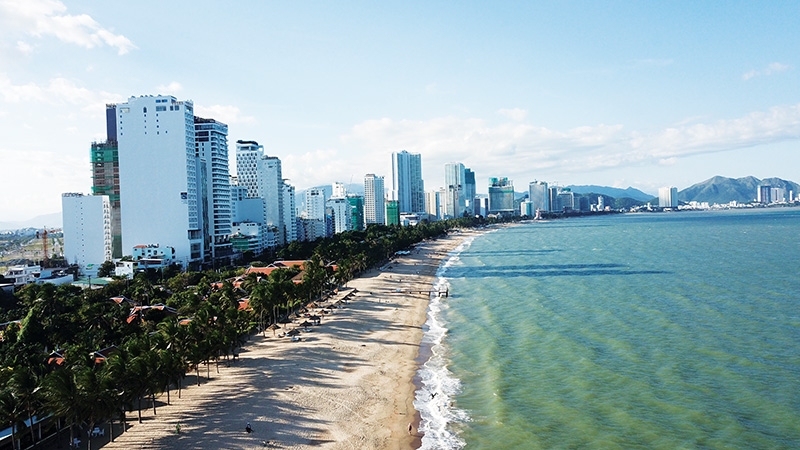Global trends in sustainable ocean economy development
 |
| Caitlin Wiesen Resident representative in Vietnam United Nations Development Programme |
The pandemic has given pause to some of these trends and called into question the kind of recovery we seek – one that is not purely economic, but green and sustainable as well.
It is therefore not surprising that for many countries driving a post-pandemic green recovery is emerging as a top concern and priority. The Organisation for Economic Cooperation and Development views the ocean as a new economic frontier, which is indispensable to a sustainable and prosperous future.
The ocean economy under a business-as-usual scenario can be expected to grow from $1.5 trillion (2010) to $3.0 trillion (2030), securing an additional nine million full-time jobs during this period. The potential to create governance and management regimes which can achieve, or over-achieve, these targets while ensuring the sustainability of our oceans is a key challenge for this decade.
Management of the ocean economy is a relatively new idea. Traditionally, it was managed through involved economic sectors, such as fisheries, shipping, and tourism. With a lower intensity of use, this approach may have been adequate. Consequently, management of the ocean was largely based on a set of economic sector-based policies, coupled with a conservation or protection policy. However, such approaches do not seem to deal with the increasing intensity of ocean activity and the cumulative pressures they create.
More holistic, ecosystem-based, and knowledge-based approaches that ensure the sustainability and resilience of marine ecosystems are needed to optimise the overall ocean economy. Integrated ocean management applies such approaches and can include a number of tools, such as an ecosystem-based management, integrated coastal zone management, and area-based measures, through imposing management control such as marine protected areas.
Efforts have recently been made to assess the ocean economy in a more integrated way, called ocean accounting, which uses international standards for the measurement of the economic, social, and environmental aspects of the ocean and coasts. National accounts for the ocean economy contain and organise information that describes countries’ economies and helps decision-makers and the public understand near-term policy outcomes and long-term sustainability issues.
National ocean accounts prioritise three indicators of the ocean economy – the ocean’s products, measured through GDP; an ocean balance sheet, which measures the change in non-produced and produced assets; and ocean income, which measures the benefits to national income attributable to ocean activities as measured through the gross national income.
The ocean economy is made up of a number of sectors. For lower middle-income countries, the ocean economy makes a significant contribution to GDP. For six selected marine sectors, the contribution to GDP over the 2005-2015 period amounts to 9-11 per cent (see figure). For ASEAN countries, these six economic sectors are close to reaching $50 billion in value.
However, each country has a specific portfolio of sectors in terms of contribution to GDP, as well as national income, and the ocean balance sheet in terms of sustainability goals. Forming ocean accounts which identify the contribution of the ocean economy to income and GDP in the broader context of sustainability is a valuable first step to realising the full national potential of the expanded ocean economy.
In addition to government initiatives, the impact investment market for the ocean has expanded rapidly, creating capital flows for investment in ocean economic activities. For example, the $5-billion Accelerating Blue Investment in Asia-Pacific will leverage public sector funds to create investment opportunities able to attract financing from a range of sources, including the private sector. Technical assistance and funds from the Asian Development Bank and other donors, along with innovative financing instruments such as revenue guarantees and credit-enhanced blue bonds, will gradually increase.
Vietnam – an important start
In the framework of the eighth meeting of the 12th Communist Party of Vietnam, the Central Committee announced Resolution No.36-NQ/TW on the strategy for the sustainable development of Vietnam’s marine economy by 2030, with a vision to 2045, which calls for developing the marine economy sustainably based on green growth and conservation of biodiversity and marine ecosystems while ensuring harmony between economic and natural ecosystems, conservation and development, and the interests of coastal and landlocked localities.
Moreover, the resolution aims to strengthen links among sectors for higher productivity, quality, efficiency, and competitiveness, while promoting the potentials and advantages of the sea and creating a momentum for national economic development.
Turning to the implementation of this important resolution, Vietnam has started to develop the country’s marine spatial planning for exploitation, sustainable use of coastal resources, and several sectoral plans for ports planning, fishery, and energy. This is the first time that Vietnam has developed robust plans related to a blue economy in a systematic manner to sustainably develop the marine economy in line with international standards.
To support and kick-off the development of these plans, the United Nations Development Programme (UNDP) is now supporting the Vietnam Administration of Sea and Islands to launch the study Blue Economy in Vietnam, which focuses on the six marine economic sectors oil and gas, renewable energy, fishery, tourism, transportation, marine ecosystem, and environment. Given the limitation of available, comprehensive, and systematic data, the study focuses on the definition, methodology, and processing of data collected from available sources.
 |
Methodology of the study
The study uses several lenses to look at the ocean economy and to advance understanding and give recommendations. Each approach may be somewhat limited by data but robustness of analysis is improved through an integrated approach which includes several factors.
First is ocean accounting. The analysis tries to adhere to the principle of ocean accounts based on the System of Environmental Economic Accounting of the UN. For each sector, the three key indicators ocean products, ocean balance sheet, and ocean income are investigated.
Secondly, for each sector several scenarios to 2030 are made under business-as-usual and other management regimes. The effect of these regimes on the ocean economy will be assessed, and some optimisation of the scenario will be considered to optimise the overall ocean economy.
Next, an analysis of costs and benefits of different approaches to the ocean economy, estimated on a sector level will be undertaken. This can help with decision making in relation to which investments are to be prioritised in the public investment programme or with development partners.
Finally, for each ocean economy sector, the interlinks of the sector to the 17 sustainable development goals (SDGs) will be assessed. The way in which the ocean economy can facilitate, or constrain, progress within the SDGs will be assessed and may help with decision-making in relation to the national efforts under Agenda 2030.
The initial review of the study shows that it is feasible for Vietnam to apply an integrated, systematic approach and advanced methods following international standards.
Firstly, despite the requirement of further capacity building, with this approach, it is possible to gradually shape the initial database for policy analysis and orientation to be more integrated and aligned with the actual situation in Vietnam. This is important for establishing a database for regular collection, compilation, and assessment.
Secondly, while sectoral development policies might be suitable for specific sectors, when viewed in a broader context, they might present irrelevant issues that need further improvement to achieve the common goal of optimising the blue economy and sustainable development. Therefore, it is necessary to have cross-sectoral integrated, spatial planning to develop the blue economy.
Lastly, it is crucial to have a close coordination mechanism among different sectors and regions throughout the collection and sharing of information, as well as basic research. Further development and implementation of marine spatial planning and other related planning requires greater coordination among stakeholders under a common and comprehensive steering organisation.
Vietnam, with its expansive coastline of 3,200km that comprises more than 3,000 big and small islands and is home to more than 50 per cent of the population living in 28 coastal provinces, has a great potential for sustainable marine economic development.
The ocean is a new economic frontier, which is indispensable to both a sustainable and prosperous future. UNDP is committed to deepening its partnership with the government of Vietnam and the Ministry of Natural Resources and Environment to formulate and implement marine economic development programmes that accelerate the country’s SDGs.
What the stars mean:
★ Poor ★ ★ Promising ★★★ Good ★★★★ Very good ★★★★★ Exceptional
 Tag:
Tag:
Themes: Climate Change Response
Related Contents
Latest News
More News
- Heavy industries set for pilot greenhouse gas quotas (December 25, 2025 | 10:00)
- Swedfund invests in MSME growth and climate action in Vietnam (December 19, 2025 | 11:42)
- GreenYellow brings solar energy to light up remote schools in Tuyen Quang province (December 19, 2025 | 08:00)
- Charge+, Grab partner to develop EV charging network in Vietnam (December 18, 2025 | 17:11)
- Linking sci-tech and innovation to Vietnam’s net-zero future (December 18, 2025 | 14:31)
- Driving double-digit growth through green and circular transformation in Vietnam (December 17, 2025 | 09:00)
- Standard Chartered and ACCA deepen collaboration to develop Vietnam’s talent for a sustainable future (December 15, 2025 | 18:18)
- Schaeffler reports strong early output from Dong Nai solar project (December 12, 2025 | 15:16)
- Forestry conference highlights biodiversity and sustainability goals (December 09, 2025 | 13:35)
- Home Credit honoured among top 10 sustainable companies in trade and services (December 09, 2025 | 12:18)






















 Mobile Version
Mobile Version